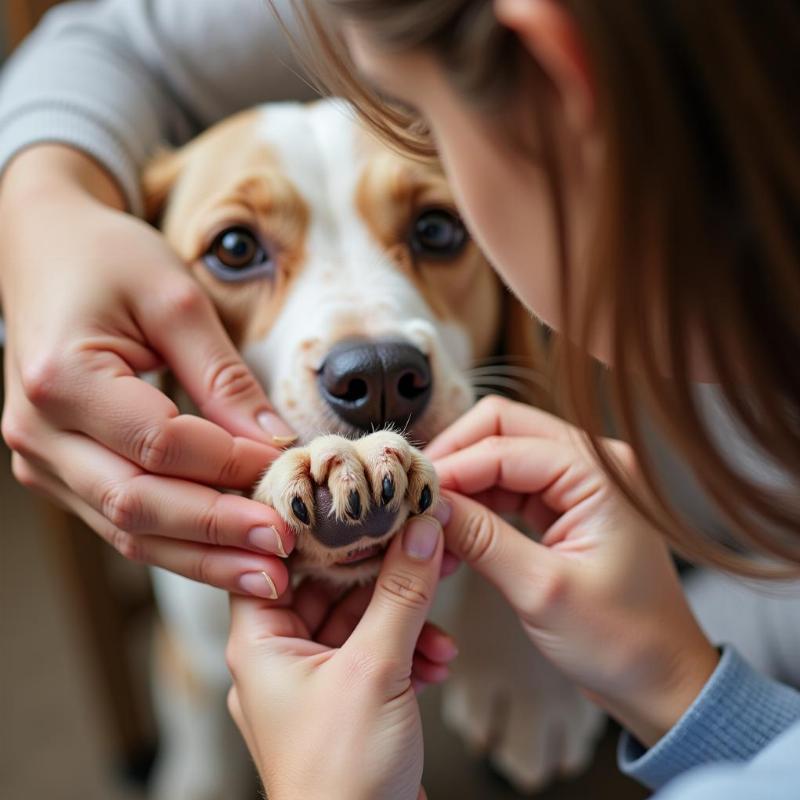A cut on your dog’s paw pad can be a painful and worrying experience for both you and your furry friend. Knowing how to identify, treat, and prevent these injuries is crucial for responsible dog ownership in the US. This guide will provide you with everything you need to know about dealing with a cut on the pad of your dog’s foot, ensuring a swift recovery and happy paws.
Recognizing a Cut on Your Dog’s Paw Pad
Identifying a paw pad injury isn’t always straightforward. Your dog might be limping, licking their paw excessively, or showing signs of discomfort when walking. You might notice visible bleeding, redness, swelling, or even debris lodged in the wound. Sometimes, the cut might be tiny and hard to spot, requiring a close examination. If your dog is exhibiting any of these symptoms, it’s important to check their paws thoroughly.
 Checking for injuries on a dog's paw
Checking for injuries on a dog's paw
Treating a Cut on Your Dog’s Paw Pad at Home
For minor cuts, you can often administer first aid at home. Start by cleaning the wound with lukewarm water and a mild antiseptic solution. Avoid using hydrogen peroxide, as it can damage the delicate tissue. Gently pat the area dry and apply a pet-safe antiseptic ointment. Bandage the paw to prevent further contamination and licking, which can impede healing. However, for deep cuts, punctures, or wounds showing signs of infection (like pus or a foul odor), veterinary care is essential.
When to Seek Veterinary Care
While minor cuts can be treated at home, deeper wounds require professional attention. If the bleeding is profuse, the cut is deep, or your dog is in significant pain, seek immediate veterinary care. Signs of infection, such as pus, swelling, redness, and a bad smell, also warrant a trip to the vet. Your veterinarian can properly clean and disinfect the wound, prescribe antibiotics if necessary, and provide pain management strategies.
Preventing Paw Pad Injuries
Preventing paw pad injuries is often easier than treating them. Regularly check your dog’s paws for cuts, thorns, or other foreign objects, especially after walks in areas with rough terrain or debris. Keep your dog’s nails trimmed to prevent them from catching and tearing. During hot weather, avoid walking your dog on hot pavement, which can burn their paw pads. Consider using dog booties for added protection in hazardous environments.
Frequently Asked Questions
- How long does it take for a cut on a dog’s paw pad to heal? Most minor cuts heal within one to two weeks. Deeper wounds may take longer.
- Can I use Neosporin on my dog’s paw pad? While generally safe, it’s best to use a pet-specific antiseptic ointment.
- How can I keep my dog from licking their injured paw? An Elizabethan collar (cone) can prevent licking and further injury.
- What are signs of infection in a paw pad wound? Pus, redness, swelling, a foul odor, and increased pain are signs of infection.
- Should I walk my dog with an injured paw pad? Limit exercise and protect the paw with a bandage or bootie.
- When should I take my dog to the vet for a paw pad injury? For deep cuts, punctures, heavy bleeding, or signs of infection, seek immediate veterinary care.
- Are there any breeds more prone to paw pad injuries? Dogs with thin or sensitive paw pads may be more susceptible.
Related Articles
About Beautdogs.us
Beautdogs.us is your premier online resource for comprehensive dog care information tailored specifically for dog owners in the US. We provide expert advice on breed-specific needs, grooming, nutrition, and overall wellness. Whether you’re a seasoned dog owner or just starting your journey with a new furry companion, Beautdogs.us offers authoritative and engaging content to help you navigate the joys and challenges of dog parenthood. For any inquiries, contact us at [email protected] or call us at +1 501-555-7529.